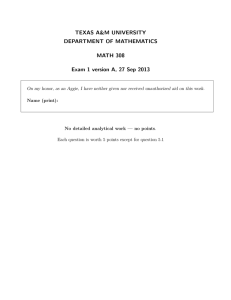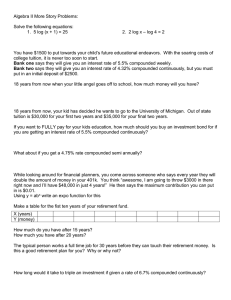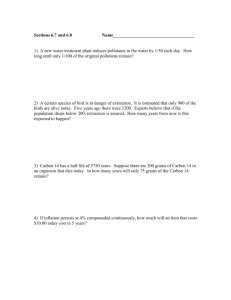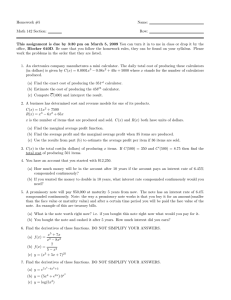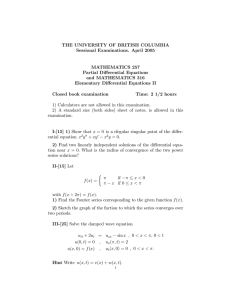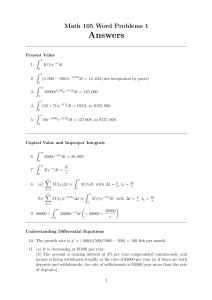Math 105 Word Problems 1 Present Value
advertisement
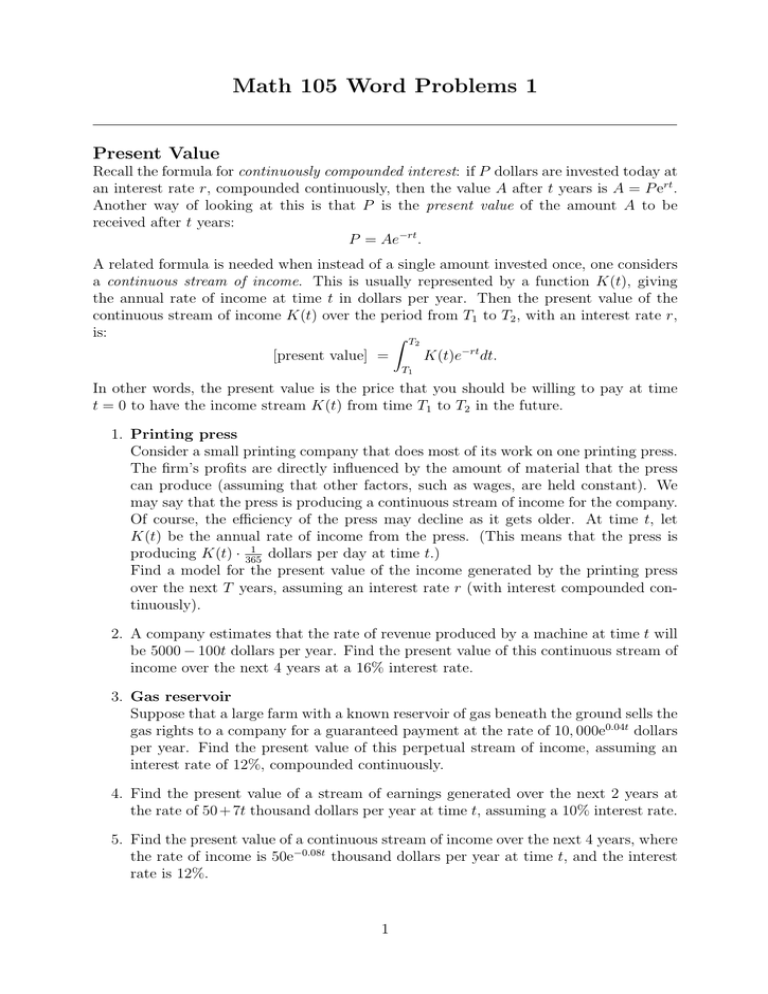
Math 105 Word Problems 1 Present Value Recall the formula for continuously compounded interest: if P dollars are invested today at an interest rate r, compounded continuously, then the value A after t years is A = P ert . Another way of looking at this is that P is the present value of the amount A to be received after t years: P = Ae−rt . A related formula is needed when instead of a single amount invested once, one considers a continuous stream of income. This is usually represented by a function K(t), giving the annual rate of income at time t in dollars per year. Then the present value of the continuous stream of income K(t) over the period from T1 to T2 , with an interest rate r, is: ∫ T2 [present value] = K(t)e−rt dt. T1 In other words, the present value is the price that you should be willing to pay at time t = 0 to have the income stream K(t) from time T1 to T2 in the future. 1. Printing press Consider a small printing company that does most of its work on one printing press. The firm’s profits are directly influenced by the amount of material that the press can produce (assuming that other factors, such as wages, are held constant). We may say that the press is producing a continuous stream of income for the company. Of course, the efficiency of the press may decline as it gets older. At time t, let K(t) be the annual rate of income from the press. (This means that the press is 1 producing K(t) · 365 dollars per day at time t.) Find a model for the present value of the income generated by the printing press over the next T years, assuming an interest rate r (with interest compounded continuously). 2. A company estimates that the rate of revenue produced by a machine at time t will be 5000 − 100t dollars per year. Find the present value of this continuous stream of income over the next 4 years at a 16% interest rate. 3. Gas reservoir Suppose that a large farm with a known reservoir of gas beneath the ground sells the gas rights to a company for a guaranteed payment at the rate of 10, 000e0.04t dollars per year. Find the present value of this perpetual stream of income, assuming an interest rate of 12%, compounded continuously. 4. Find the present value of a stream of earnings generated over the next 2 years at the rate of 50 + 7t thousand dollars per year at time t, assuming a 10% interest rate. 5. Find the present value of a continuous stream of income over the next 4 years, where the rate of income is 50e−0.08t thousand dollars per year at time t, and the interest rate is 12%. 1 Capital Value and Improper Integrals The capital value of an asset such as a machine is sometimes defined as the present value of all future net earnings. The actual lifetime of the asset may not be known, and since some assets may last indefinitely, the capital value of the asset may be written in the formula ∫ ∞ [capital value] = K(t)e−rt dt, 0 where r is the annual rate of interest compounded continuously. 6. Find the capital value of an asset that generates income at the rate of $5000 per year, assuming an interest rate of 10%. 7. Construct a formula for the capital value of a rental property that will generate a fixed income at the rate of K dollars per year indefinitely, assuming an annual interest rate of r. 8. Machine maintenance Suppose that a machine requires daily maintenance, and let M (t) be the annual rate of maintenance expense at time t. (a) Give a Riemann sum with n rectangles that approximates the total maintenance expense over the next 2 years. Then write the integral that the Riemann sum approximates for large values of n. (b) Give a Riemann sum with n rectangles that approximates the present value of the total maintenance expense over the next 2 years using a 10% annual interest rate compounded continuously. Then write the integral that the Riemann sum approximates for large values of n. 9. Capitalized Cost The capitalized cost of an asset is the total of the original cost and the present value of all future ”renewals” or replacements. This concept is useful, for example, when selecting equipment that is manufactured by several different companies. Suppose that a corporation computes the present value of future expenditures using an annual interest rate r, with continuous compounding of interest. Assume that the original cost of an asset is $80, 000 and the annual renewal expense will be $50, 000, spread more or less evenly throughout each year, for a large but indefinite number of years. Find a formula involving an integral that gives the capitalized cost of the asset. 2 Understanding Differential Equations 10. Fish in a lake A lake is stocked with 100 fish. Let f (t) be the number of fish after t months, and suppose that y = f (t) satisfies the differential equation y 0 = .0004y(1000 − y). The figure below shows the graph of a solution to this differential equation. The graph is asymptotic to the line y = 1000, the maximum number of fish that the lake can support. How fast is the fish population growing when it reaches one-half of its maximum population? 1000 800 600 y(t) 400 200 5 t 10 15 11. A savings account Let f (t) be the balance in a savings account at the end of t years. Suppose that y = f (t) satisfies the differential equation y 0 = .04y − 2000. (a) If after 1 year the balance is $10,000, is it increasing or decreasing at that time? At what rate is it increasing or decreasing at that time? (b) The balance in a bank account can change due to interest (yes, there was a time when savings accounts paid significant interest), withdrawals and/or deposits. Describe in words what might be happening in this account. 12. A certain piece of news is being broadcasted to a potential audience of 200, 000. Let y(t) be the number of people who have heard the news after t hours, and y 0 = .07(200, 000 − y), y(0) = 10. Describe this initial value problem in words. 13. Rate of net investment Let f (t) denote the amount of capital invested by a certain firm at time t. The rate of change of invested capital, f 0 (t), is sometimes called the rate of net investment. The management of the firm decides that the optimum level of investment should be C dollars and that, at any time, the rate of net investment should be proportional to the difference between C and the total capital invested. Construct a differential equation that describes this situation. 3 Solving Differential Equations 14. Retirement account You invest in a retirement account that pays 6% interest per year. You make an initial deposit of $1000 and plan on making future depositis at the rate of $2400 per year. Assume that the deposits are made continuously and that interest is compounded continuously. Let P (t) denote the amount of money in the account t years after the inital deposit. Set up an initial value problem that is satisfied by P (t), and use it to find P (t). 15. Paying off a car loan You took a loan of $25, 000 to pay for a new car. The interest rate on the loan is 5%. You arranged through your online banking to make daily payments totaling $4800 per year. This allows you to assume that your payments are flowing continuously into your account. Let P (t) denote the amount that you owe on the loan at time t (in years). Assume that interest is compounded continuously. Set up an initial-value problem that is satisfied by P (t) and solve it. 16. Truck drivers and accidents Let t represent the total number of hours that a truck driver spends during a year driving on a certain highway connecting two cities, and let p(t) represent the probability that the driver will have at least one accident during these t hours. Then 0 ≤ p(t) ≤ 1, and 1 − p(t) represents the probability of not having an accident. Under ordinary conditions, the rate of increase in the probability of an accident (as a function of t) is proportional to the probability of not having an accident. Construct and solve a differential equation for this situation. 17. Construction Cost Index Some American homeowner’s insurance policies include automatic inflation coverage based on the US Commerce Department’s construction cost index (CUI). Each year the property insurance coverage is increased by an amount based on the change in the CCI. Let f (t) be the CCI at time t years since January 1, 1990, and let f (0) = 100. Suppose that the construction cost index is rising at a rate proportional to the CCI and the index was 115 on January 1, 1992. Construct and solve a differential equation satisfied by f (t). Then determine when the CCI will reach 200. 18. A model relating price and sales A model that describes the relationship between the price and the weekly sales of a product might have a form such as ( ) dy 1 y =− , dp 2 p+3 where y is the volume of sales and p is the price per unit. That is, at any time the rate of decrease of sales with respect to price is directly proportional to the sales level and inversely proportional to the sales price plus a constant. Solve this differential equation. 4 Areas between curves 19. World oil consumption At the start of 1974 the world was consuming oil at a rate of 21.3 billion barrels per year, and this rate had been growing exponentially for many years, with a growth constant of 7% per year. Thus if R(t) is the rate of oil consumption (in billions of barrels per year) at time t (measured in years), where t = 0 is the start of 1974, for t < 0 we have R(t) = 21.3e0.07t . However, at the start of 1974, oil prices rose dramatically. This didn’t reduce R(t), but it did reduce the rate of increase of R(t): the growth constant changed from 7% to 4%. Thus for t > 0 we have R(t) = 21.3e0.04t . Determine how much oil was saved from t = 2 to t = 6 (i.e. in the four years 1976, 1977, 1978 and 1979) by this change, i.e. the difference between what the oil consumption would have been with R(t) = 21.3e0.07t and what it was with R(t) = 21.3e0.04t . 20. Refer to problem 19. Suppose that in 1970 the growth constant for the annual rate of oil consumption had been held to .04. What effect would this action have had on oil consumption from 1970 to 1974? 21. Deforestation Deforestation is one of the major problems facing sub-Saharan Africa. Although the clearing of land for farming has been the major cause, the steadily increasing demand for fuel wood has become a significant factor. The rate of fuel wood consumption (in millions of cubic metres per year) in the Sudan t years after 1980 is given approximately by the function c(t) = 76.2e0.3t . Determine the amount of fuel wood that was consumed from 1980 to 2000. The rate of new tree growth (also in millions of cubic metres per year) in the Sudan t years after 1980 is given approximately by the function g(t) = 50 − 6.03e0.09t . Assuming that after 2000 new tree growth continues according to this function, what happens midway through 2003? Can you explain this? Finally, set up the definite integral giving the amount of depletion of the forests due to the excess of fuel wood consumption over new growth from 1980 to 2000. 22. Marginal profit Let P (x) be the profit for a certain company when the production level is x. The production level is currently 6, but is expected to rise to 8. Under current conditions, the derivative P 0 (x), which is called the marginal profit, is −x2 +14x−24. However, management is considering a new plan. This would leave P (6) the same, but would change the marginal profit to −x2 + 12x − 20. Under the new plan, would P (8) be more than what it would have been under the old plan, or would it be less? How much of a difference does it make? 5

